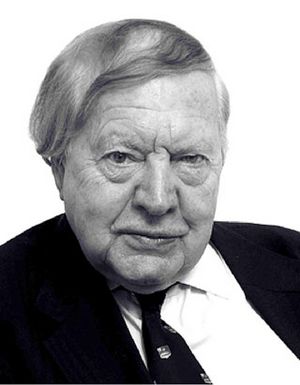Noel Hush facts for kids
Quick facts for kids
Noel Hush
|
|
|---|---|

Hush in 2006
|
|
| Born |
Noel Sydney Hush
15 December 1924 Sydney, New South Wales, Australia
|
| Died | 20 March 2019 (aged 94) |
| Nationality | Australian, UK |
| Known for | Electron transfer, molecular electronics, finite-field response |
| Awards |
|
| Scientific career | |
| Fields | Theoretical chemistry, chemical physics |
| Institutions | University of Manchester, University of Bristol, University of Sydney |
| Thesis | The electronic spectrum of pentacene in five states of ionization: theory and experiment |
| Doctoral advisors | (DSc 1959) H.C. Longuet-Higgins FRS and M.H.L. Pryce FRS |
Noel Sydney Hush (born December 15, 1924 – died March 20, 2019) was an important Australian chemist. He worked at the University of Sydney for many years. He was known for his amazing work on how tiny particles called electrons move.
Contents
Noel Hush's Life and Work
Noel Hush was born in Sydney, Australia, on December 15, 1924. He studied at the University of Sydney, earning his first degree in 1945 and a master's degree in 1948. After his studies, he worked there as a research fellow.
In 1950, he moved to England. He worked at the University of Manchester and then at the University of Bristol. He was a lecturer and later a reader in chemistry.
Founding a New Department
Noel Hush returned to Australia in 1971. He started the first Department of Theoretical Chemistry at the University of Sydney. This was a big step for science in Australia.
After 1989, he became a full-time research professor. He visited many universities around the world. He shared his knowledge in Australia, the UK, and the US.
Understanding Electron Transfer
One of Noel Hush's main research areas was electron transfer. This is how electrons move from one molecule to another. It's a key process in many natural reactions. These reactions are called oxidation-reduction processes. They happen everywhere, from simple chemicals to living things.
For a long time, scientists didn't know how these reactions worked. In the 1950s, studies showed it was about how electrons and vibrations interact. Hush's work helped explain that electron transfer can happen when molecules bump into each other. He showed that this process can happen in two ways: by light (optical) or by heat (thermal).
Awards and Recognition
Noel Hush received many awards for his important scientific work. Here are some of them:
- 2014 Ahmed Zewail Prize for Molecular Science
- 2011 Foreign Associate of the National Academy of Sciences of USA
- 2010 Fellow of the Royal Society of New South Wales
- 2007 Welch Award
- 2005 Physical Division Medal of the Royal Australian Chemical Institute
- 2001 Australian Federation Centenary Medal
- 2000 Inaugural David Craig Medal and Lecture of the Australian Academy of Science
- 1999 Foreign Member of the American Academy of Arts and Sciences
- 1994 Matthew Flinders Medal and Lecture from the Australian Academy of Science
- 1993 Officer of the Order of Australia
- 1990 Centenary Medal of the Royal Society of Chemistry
- 1988 Fellow of the Royal Society
- 1977 Fellow of the Australian Academy of Science
- 1977 Fellow of the Royal Australian Chemical Institute
See also
- Electron transfer

